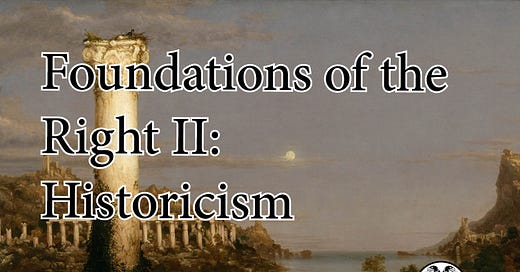If you prefer audio of this article, click here.
Esotericist recently wrote another excellent article where he shows the limited use of the left-right typology. He is absolutely right about this. Nevertheless, it is one of our most basic political categories, so as we continue on in our series working out the foundations of the right, we should keep in mind the term’s limitations and unclarity. It’s just this unclarity that calls for such a series in the first place.
There are not a few on the political right who enjoy the aesthetics of the right but misjudge the foundations, and who are sometimes hostile to those foundations. They like the great thinkers of the past, the art, the high culture, but not what gives rise to those things, which often comes many centuries before the high culture itself. They often mistake the fruit for the plant, as though the crown is somehow more important than the root. Often these people talk about “transcendence”, ground their worldview in metaphysics, and give short shrift to the things of this world, the “mud and blood” of history. In reality, metaphysics and so on is grounded in the historical, not the other way around.
This would seem to denigrate myth as something less than foundational. Myth is quite significantly “not of this world”, outside of time—we give this a name: mythic time. This mythic time is seen perhaps most purely in the Australian Aboriginal concept of the Dreamtime, a kind of “everywhen”, where among other things, Tiddalik the Frog is never not drinking and disgorging the world ocean. I am here to tell you that myth is less foundational than something else. Is this a denigration? I suppose that depends on how you view these things.
What is more foundational than myth is something that doesn’t really have a name, and answers only very imperfectly to the name of history.1 Comprised under this imperfect term of history is everything that is not “everywhen”, but here, in this or that place, at this or that time—and the emphasis on such things is what we will call, in the broadest sense, historicism. Historicism is everything emphasizing lineage, temporality, and tradition. Historicism emphasizes the immanent world of the senses, and takes the “otherworld” to be continuous with and interpenetrated by, this world. We as Europeans have it in our bones, which is why even our myth happens in “this” world, and is entangled with historical personages.
Historicism says that there is no view from nowhere, from “outside” a perspective. In the ancient world, this took the form of the annals of the city, of the chronicles of founders, of epic, saga, and singing the deeds of the forefathers. In the modern world, it was reborn with the Renaissance, found its greatest poet in Shakespeare, its greatest theorist in Vico, its greatest political expression in absolutism, its greatest aesthetic in Romanticism, and its greatest historian in Spengler. It has always run as a counter-current to liberalizing tendencies, which are fundamentally at odds with it.
So how did we get away from it? The answer is that we’ve gotten away from it many times, and it has always come back. In late antiquity, there was a de-emphasis on the particularity of the city, a de-emphasis on its annals maintained by a hollowed-out priesthood, and a reorientation toward cosmopolitanism—toward the “world as polis”, as seen in the rise of the Neoplatonists, Cynics, Stoics, and the Epicureans. This culminated in early Christianity, and especially in its revisionism. This all augured the end of that world, after which historicism in the form of saga, folklore, and epic returned with a vengeance. In the modern period, we again threw off this vitalist historicity, this Odinic “magician-king” worldview,2 and liberalism brought in its own revisionism, its own year-zero ideology—we again rejected tradition and decontextualized man. But just as in the ancient world, historicism was always there, in the background, still at the root of all that is deep and glorious.
Historicism is forever, but its opposite comes and goes. Historicism is an island surrounded by the waters of Axiality, or we could say, of liberalism. As liberalism surges, the island is covered over; as liberalism ebbs away, the bedrock of historicism is again exposed. The bedrock never disappears; never is there a time where it is gone, or doesn’t form the foundation—it is only ever occluded. The great times of historicism in this wider sense were the archaic period just before the Axial age and the early medieval world after the collapse of antiquity. Interestingly, all our myths were born in these periods of great realism, when men were distinctly earthbound, this-worldly, and concerned with the deeds of great men. Today we are entering into another such period.




